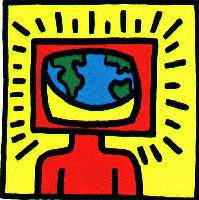 Michael Faraday, who was the father of electric motor technology, has been cited several times in Toobworld over the last few months, most recently in a blipvert for the Dyson vacuum cleaner. (James Dyson mentions Faraday's creation of his motor in 1831.)
Michael Faraday, who was the father of electric motor technology, has been cited several times in Toobworld over the last few months, most recently in a blipvert for the Dyson vacuum cleaner. (James Dyson mentions Faraday's creation of his motor in 1831.)Here's the handy-dandy biography for Faraday from Wikipedia:
Michael Faraday, FRS (September 22, 1791 – August 25, 1867) was an English chemist and physicist (or natural philosopher, in the terminology of that time) who contributed to the fields of electromagnetism and electrochemistry.
Faraday studied the magnetic field around a conductor carrying a DC electric current, and established the basis for the magnetic field concept in physics. He discovered electromagnetic induction, diamagnetism and electrolysis. He established that magnetism could affect rays of light and that there was an underlying relationship between the two phenomena. His inventions of electromagnetic rotary devices formed the foundation of electric motor technology, and it was largely due to his efforts that electricity became viable for use in technology.
In the 'Nova' section of PBS.org, there are pages dedicated to a special episode about "Einstein's Big Idea", that being the equation "E=MC2".
Here's some of what they had to say about Faraday:
Faraday went on to make other important discoveries, including the principle behind the electric transformer and generator, innovations that fueled the Industrial Revolution.
In his day, Faraday was celebrated as a great experimenter, but many elite scientists spurned Faraday's more theoretical notions, particularly his vision that the area around an electromagnetic event is filled with a mysterious "field," and his idea that light itself might be an electromagnetic phenomenon.
You can find more about him at his page for "Einstein's Big Idea".
In the 'Nova' section of PBS.org, there are pages dedicated to a special episode about "Einstein's Big Idea", that being the equation "E=MC2".
Here's some of what they had to say about Faraday:
Faraday went on to make other important discoveries, including the principle behind the electric transformer and generator, innovations that fueled the Industrial Revolution.
In his day, Faraday was celebrated as a great experimenter, but many elite scientists spurned Faraday's more theoretical notions, particularly his vision that the area around an electromagnetic event is filled with a mysterious "field," and his idea that light itself might be an electromagnetic phenomenon.
You can find more about him at his page for "Einstein's Big Idea".
 Faraday was portrayed in that episode by Steven Robertson, and it looks like he'll be the official televersion of Faraday in Toobworld. In that same year of 2005, Robertson played the physicist again in "E=MC2" on Britain's Channel 4.
Faraday was portrayed in that episode by Steven Robertson, and it looks like he'll be the official televersion of Faraday in Toobworld. In that same year of 2005, Robertson played the physicist again in "E=MC2" on Britain's Channel 4.
Faraday could be an honorary inductee into the TV Crossover Hall of Fame, as he was also portrayed in a 2004 mini-series ("100 Greatest Discoveries") by James Thompson. And his life in Toobworld can be augmented by two TV series in which his contributions are off-screen, and both of those series are related to each other.
In the episode of 'Doctor Who' entitled "The Mark Of The Rani" the Sixth Doctor and Peri were in Killingworth, England at the height of a Luddite rebellion in the year 1822. (The date was established by author Lance Parkin in his "AHistory".) The Doctor's arch-nemesis, the Master, was plotting to abduct several of the leaders of the Industrial Revolution, including George Stephenson and Faraday. We get to meet Stephenson, but Faraday never does arrive on the scene while the Doctor is in Killingworth.
 Nearly ten years later, in that same year mentioned in the commercial for the Dyson vacuum, 1831, Faraday demonstrated the principle of electromagnetic induction. He never realized it would have a practical application in the future, producing electric transformers. But Clan Slitheen of Raxicoricofallapatorius did - in "Revenge Of The Slitheen", one of 'The Sarah Jane Adventures', the aliens tried to destroy the Earth using technology based on his principles.
Nearly ten years later, in that same year mentioned in the commercial for the Dyson vacuum, 1831, Faraday demonstrated the principle of electromagnetic induction. He never realized it would have a practical application in the future, producing electric transformers. But Clan Slitheen of Raxicoricofallapatorius did - in "Revenge Of The Slitheen", one of 'The Sarah Jane Adventures', the aliens tried to destroy the Earth using technology based on his principles. There's another reason why Michael Faraday has come under notice due to Television, not that he's been explicitly mentioned. A new character on 'Lost', Daniel Faraday, is meant to invoke comparison to Faraday as Daniel is also a physicist. (Although as he told Sayid, ''I guess you could call me a physicist.... I don't like to be pigeon-holed.'') As Doc Jensen of EW.com noted, when Daniel observed how the sunlight on the Island "doesn't scatter quite right", it was the kind of anomalous phenomenon that Michael Faraday might have noticed.
There's another reason why Michael Faraday has come under notice due to Television, not that he's been explicitly mentioned. A new character on 'Lost', Daniel Faraday, is meant to invoke comparison to Faraday as Daniel is also a physicist. (Although as he told Sayid, ''I guess you could call me a physicist.... I don't like to be pigeon-holed.'') As Doc Jensen of EW.com noted, when Daniel observed how the sunlight on the Island "doesn't scatter quite right", it was the kind of anomalous phenomenon that Michael Faraday might have noticed.So there's the background necessary for the televersion of this historical figure.
BCnU!
Toby OB




No comments:
Post a Comment